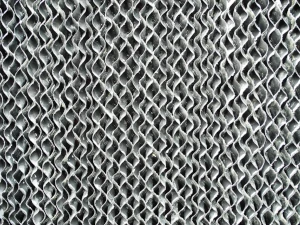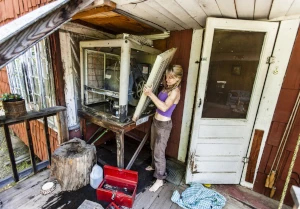When it comes to cooling homes and indoor spaces in America, air conditioning is king. But if you are somewhere from the western United States or anywhere with a hot yet very dry climate, you may have another preferred option for cooling: the swamp cooler.
No, it is not at all related to an actual swamp. It is a nickname for the device called an evaporative cooler, which cools a room through the process of evaporation.
What are the key differences between traditional air conditioning vs swamp cooler? What should you consider before making the switch from one to the other? What are the perks and downsides of each cooling device?
Continue reading to learn the answers.
Which are Better: Air Conditioners or Evaporative Coolers?
Both the air conditioning system and evaporative cooler (or swamp cooler) have their distinct advantages and drawbacks. Choosing which one is superior will depend on individual families’ local climate, budget, and comfort needs.
Choose the air conditioner if:
- You need to lower the temperature of your home as well as remove excess humidity
- You live in a climate where it gets hot and can get exceptionally humid
- You want a system that provides consistent comfort but requires less frequent maintenance
- You are allergic to pollen, dust, and other outdoor air pollutants and want to filter them from your breathing air
- You don’t mind consuming a substantial amount of energy for the sake of maximum comfort
Pick the swamp cooler if:
- You need to lower the temperature of your home but increase the humidity
- Your local climate is hot but can be exceedingly dry like in the desert
- You want to save money on utility bills
- You want a more environment-friendly system
- You want fresh air to flow into your house while the cooling device is running
Both air conditioners and evaporative coolers can be installed as a central system for you to manage the temperature and humidity of your entire home. There are also portable or room devices for both devices available in the market.
Difference Between Air Conditioning and Swamp Coolers
In the quest for optimal indoor comfort, people choose between two popular cooling solutions: air conditioners and swamp coolers (evaporative coolers). How do factors such as climate, cost, and energy efficiency impact whether you will choose one or the other?
Air Conditioner
Air conditioners (AC) are the most common choice for cooling homes and commercial spaces. This system operates by using a refrigerant to absorb heat from the indoor air and expel it outside, thereby lowering the room temperature. Air conditioners have the following attributes:
- Functionality: AC units can cool, dehumidify, and recirculate air.
- Climate suitability: they perform well in any climate, including areas with high humidity.
- Energy consumption: air conditioners tend to use more energy compared to swamp coolers.
- Installation: they can be installed as central systems or as individual units depending on the size and cooling needs of the space.
Swamp Cooler
Swamp coolers, also known as evaporative coolers, provide cooling by evaporating water to decrease the air temperature. A fan draws warm air through wet pads, where it absorbs moisture and releases cooler air. Some key features of swamp coolers include:
- Functionality: evaporative coolers primarily cool and add humidity to the air.
- Climate suitability: they are best suited for dry climates with low humidity.
- Energy consumption: swamp coolers consume less energy compared to air conditioners due to their simpler design.
- Installation: they can be installed either as central units or as portable devices, depending on the application.
Understanding the fundamental differences between an air conditioner and a swamp cooler can help consumers make informed decisions about the best cooling solution for their specific needs and local climate conditions.
Factors to Consider When Choosing a Cooling System
When deciding between an air conditioning system and a swamp cooler, various factors come into play: Climate, Environment, Energy Efficiency, Cost Considerations, and Maintenance.
Climate
The climate is a significant factor in choosing a cooling system. In areas with high humidity levels, an air conditioning system is more suitable as it dehumidifies the air while cooling it. A swamp cooler, on the other hand, is more effective in dry climates, as it adds moisture to the air.
Environment
Air conditioning systems use refrigerants, which are chemicals that may have an impact on the environment if not managed properly. Some refrigerants contribute to global warming and the depletion of fossil fuels. Swamp coolers, by contrast, use water as their cooling medium and have a lesser environmental impact.
Energy Efficiency
Energy efficiency is another critical aspect to consider. Swamp coolers consume less energy compared to central air conditioning units, leading to lower energy usage and costs. However, for high-humidity environments, the energy savings might not offset the drop in comfort levels as the swamp cooler could struggle to maintain the desired temperature.
Cost Considerations
Installation, maintenance, and energy costs should be evaluated when choosing a cooling system:
- Installation: Swamp coolers are generally less expensive to install than air conditioning systems.
- Maintenance: Swamp coolers usually require more frequent maintenance than air conditioning systems, due to the need to clean and replenish water.
- Energy Costs: Air conditioning systems are typically more expensive to operate due to higher energy consumption, while swamp coolers have lower energy costs given their more energy-efficient nature.
Maintenance
Maintenance requirements and costs can also influence the choice between air conditioning and swamp cooling. Air conditioning systems typically require less maintenance overall, focusing mainly on routine checks and filter replacements. Swamp coolers, however, require more regular maintenance, including cleaning the water reservoir and adding water when necessary, plus regular pad replacements to prevent the growth of mold and bacteria.
Comparing AC and Swamp Coolers
Installation and Operation
When comparing the installation process of air conditioning and swamp coolers, it is important to consider factors such as costs and size. Generally, swamp coolers are less expensive to install than air conditioning units, as they consist of fewer components and require less specialized skills for setup. Due to their evaporative cooling method, swamp coolers are most effective in dry climates, while air conditioning can operate efficiently in various climate conditions.
In terms of operation, swamp coolers add moisture to the air through evaporation, which can be beneficial in dry climates. However, it is vital to keep windows open to allow proper airflow and to prevent excessive humidity buildup that can lead to mold or mildew growth. Conversely, air conditioners use chemical refrigerants to remove heat and moisture from the air, providing a more consistent indoor temperature and humidity level.
Air Quality
A key factor to consider when comparing air conditioning and swamp coolers is the impact on air quality. Swamp coolers draw fresh air from the outside, which can be beneficial for circulating indoor air. However, they can also introduce pollen, dust, or other allergens, and might require frequent water tank cleaning to prevent mold and mildew growth.
Air conditioning units, on the other hand, can filter and recirculate indoor air, reducing the infiltration of outdoor allergens. However, they may also contribute to indoor air pollution if not properly maintained, such as refrigerant leaks or inefficient filters.
Energy Efficiency
Swamp coolers consume less electricity than air conditioners, making them a more energy-efficient option for cooling. Air conditioners require more energy to operate, as they employ complex apparatus and refrigerants to remove heat from the air. However, advancements in technology have led to the development of energy-efficient air conditioning models, which can help minimize energy consumption and associated costs.
Noise and Emissions
Swamp coolers generally produce less noise than air conditioning units, as they operate by utilizing a water pump rather than a compressor. However, both options can be designed to minimize noise, and the specific level depends on the individual unit’s size and design.
In terms of emissions, swamp coolers consume water and have a lower carbon footprint compared to air conditioners. On the other hand, air conditioners produce CO2 emissions due to their energy consumption and usage of chemical refrigerants. Therefore, swamp coolers are considered a more eco-friendly option for cooling.
Temperature Control
Temperature control is essential for both air conditioning and swamp coolers, and it has a significant impact on indoor comfort levels. Air conditioners provide precise temperature control by adjusting the thermostat settings, whereas swamp coolers regulate humidity levels to achieve their cooling effect.
While swamp coolers excel at cooling dry climates, their performance is less efficient in areas with high humidity levels. Air conditioners, however, are capable of maintaining consistent temperatures and humidity levels, regardless of the outdoor climate. This makes them a more versatile choice for temperature control in various environments.
Potential Issues and Solutions
You may wonder whether there are potential issues when using air conditioning systems and swamp coolers. If there are, what are the solutions?
Mold and Mildew
Mold and mildew can be a concern in both air conditioning systems and swamp coolers, as both involve the circulation of air and moisture throughout a space. For air conditioning, mold and mildew can accumulate in ductwork if the humidity levels are not properly maintained. In swamp coolers, mold and bacteria can grow on the panels and minerals may build up in the cooling solution.
To prevent mold problems in air conditioning systems, ensure proper sealing and insulation of ducts, regularly clean the ductwork, and maintain appropriate humidity levels. For swamp coolers, clean the panels and cooling solution regularly, and use a water conditioner to minimize mineral buildup.
Refrigerant Leaks
Refrigerant leaks are an issue primarily associated with air conditioning systems. A leak in the coolant system can reduce energy efficiency and may result in the compressor working harder to maintain the lower temperature, leading to increased wear and tear. Addressing a refrigerant leak promptly is essential to maintaining the lifespan and efficiency of the cooling system.
To mitigate refrigerant leaks, schedule regular maintenance on the air conditioning system and replace any damaged or worn components as needed. In the case of a leak, a certified HVAC technician should be called in to repair the issue.
High Humidity Climates
In high-humidity climates, it is important to consider which cooling system can provide the most effective solution. Swamp coolers can struggle in humid climates, as their method of cooling relies on evaporative processes. When the air is already humid, the efficiency of evaporative cooling is reduced, resulting in less effective cooling on hot days.
Air conditioning systems, on the other hand, dehumidify the air as part of their cooling process, which can be beneficial in humid climates. Consider the local climate when choosing between these two cooling options. In humid climates, air conditioning systems may be the better option for maintaining comfortable indoor temperatures.


